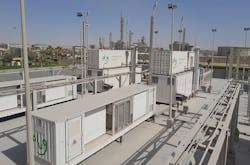Plug Power Supplying 3 GW of Electrolyzer Capacity to Allied Green Ammonia's Hydrogen-to-Ammonia Facility in Australia
A major developer of hydrogen technology is having a big week, with $1.6 billion in U.S. loan commitments and a new contract in Australia.
Plug Power, a manufacturer of comprehensive hydrogen solutions for the green hydrogen economy, has signed a memorandum of understanding (MOU) with Allied Green Ammonia (AGA), an Australian company producing green ammonia, to supply up to 3 GW of Plug electrolyzer capacity for AGA’s upcoming hydrogen-to-ammonia facility proposed for the Northern Territory of Australia.
Additionally, Plug and AGA plan to enter an agreement, as outlined in the MOU, to initiate a Basic Engineering and Design Package (BEDP) for the 3 GW capacity project. The BEDP is expected to advance mid-May 2024, with a final investment decision planned for Q4 2025 and the progressive delivery of the 3 GW electrolyzer supply scheduled to start in Q1 2027.
“Ammonia producers have recognized the substantial advantages of cost and carbon reduction through electrolysis-based hydrogen,” said Plug CEO Andy Marsh. “We’re thrilled to sign this MOU and partner with AGA. Our expertise in constructing and operating large-scale hydrogen production facilities and our PEM electrolyzer manufacturing capability to support their 3GW project position us as the ideal partner for this endeavor.”
The U.S. Department of Energy's Loan Program Office announced that it selected Plug Power for a $1.66 billion loan conditional commitment to help the company finance development of green hydrogen production facilities to be built across the U.S.
Hydrogen does not contain carbon in its chain so does not emit CO2 when combusted. It can be generated several ways, but to be truly classified as green hydrogen it must be produced from electrolzyers powered by carbon-free resources such as solar, wind, hydro and nuclear.
Green hydrogen produced by Plug’s electrolyzers is expected to help decarbonize the ammonia production process by displacing Steam Methane Reforming (SMR) techniques. Plug's pressurized (40 bar) electrolyzer will also decrease downstream compression requirements and the extracted oxygen from electrolysis-based hydrogen. This is anticipated to improve efficiency in industrial power plants and furnaces due to its high-temperature combustion capability.
In Australia, AGA’s facility will produce 2500 metric tons per day (TPD) of green ammonia and is geographically positioned to meet AGA’s intended customers’ growing needs, providing them with a reliable and secure supply of green ammonia from the region.
Plug currently operates a PEM electrolyzer deployment in the United States at its 15 TPD Georgia hydrogen plant. This announcement follows Plug’s BEDP contracts totaling 4.5 GW across the United States and Europe.
About the Author
EnergyTech Staff
Rod Walton is senior editor for EnergyTech.com. He has spent 17 years covering the energy industry as a newspaper and trade journalist.
Walton formerly was energy writer and business editor at the Tulsa World. Later, he spent six years covering the electricity power sector for Pennwell and Clarion Events. He joined Endeavor and EnergyTech in November 2021.
He can be reached at [email protected].
EnergyTech is focused on the mission critical and large-scale energy users and their sustainability and resiliency goals. These include the commercial and industrial sectors, as well as the military, universities, data centers and microgrids.
Many large-scale energy users such as Fortune 500 companies, and mission-critical users such as military bases, universities, healthcare facilities, public safety and data centers, shifting their energy priorities to reach net-zero carbon goals within the coming decades. These include plans for renewable energy power purchase agreements, but also on-site resiliency projects such as microgrids, combined heat and power, rooftop solar, energy storage, digitalization and building efficiency upgrades.
